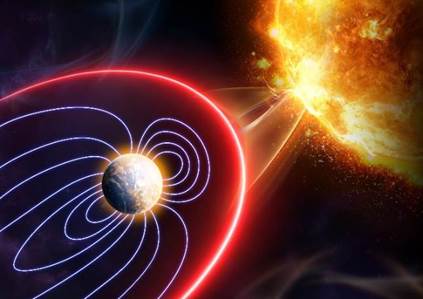Recently, Professor Liu Jing's research group, from School of Space Science and Physics, Institute of Space Sciences in collaboration with Dr. Wang Wenbin from National Center for Atmospheric Research, Dr. Liu Libo from institute of Geology and Geophysics, Chinese Academy of Science, and Prof. William Lotko from Dartmouth College, has published their new progress entitled " Solar flare effects in the Earth’s magnetosphere " in Nature Physics.
The flare is the most violent explosion phenomenon of the solar atmosphere. In just one to twenty minutes, the flare can release the energy equivalent to the explosion of billions of million-ton hydrogen bombs, resulting in the sudden enhancement of almost all band electromagnetic radiation, such as X-ray and extreme ultraviolet radiation. At 09:10 universal time on September 6, 2017, an X2.2 solar flare occurred. Three hours later, a more powerful X9.3 flare also took place, being the strongest flare event observed in the 24th solar cycle. According to the space weather center of the National Oceanic and Atmospheric Administration (NOAA) of the United States, the flare event caused the high-frequency radio communication on the dayside of the Earth to "fail in a large range, and the lost connection time was as long as one hour."
What process caused the interruption of radio communication? This has to do with the ionosphere, known as the "mirror hanging in the sky." The ionosphere is produced by solar radiation ionizing the earth's upper atmosphere, which is located 60-1000 km above the ground. When a flare erupts, with the intensified solar radiation, the ionization process in the atmosphere increases significantly, resulting in the rapid increase of electron density and sudden ionospheric disturbance. At this time, the high-frequency radio waves propagating in the ionosphere will be suddenly attenuated or even interrupted, which directly affects the radio communication, especially the short-wave communication (including TV station, radio station, etc.), and also affects the signal transmission and positioning accuracy of the navigation system. In addition, flares can also heat neutral gas, increase the atmospheric density and resistance of low earth orbit spacecraft such as Shenzhou and Tiangong, and make spacecraft need more fuel to maintain their positions, thus affecting its lifespan.
The magnetosphere is located in the region above the ionosphere and is the fully ionized space region above 1000 km from the ground. The region is surrounded by the solar wind, and is affected and controlled by the earth's magnetic field and the solar wind's magnetic field. Because solar wind particles cannot penetrate the earth's magnetosphere and enter the earth's space directly, the magnetosphere is generally regarded as the earth's "barrier" against the "attack" of solar wind particles. However, when the direction of the solar wind is opposite to the magnetic field of the earth's magnetosphere, the magnetic lines from the two regions will "connect", leading to the direct transmission of particles in the solar wind to the earth space. So, can the flare process, which is characterized by enhanced radiation, not only directly affect the earth's ionosphere, but also cause disturbance in the magnetosphere like the solar wind?
In order to solve this scientific problem, Professor Liu Jing's team of Space Science Research Institute of Shandong University has adopted a series of observation datasets, including global satellite navigation system, European incoherent scattering radar network, ionospheric satellite and lunar orbiting satellite, etc. This work also uses a large-scale numerical model: high spatial-temporal resolution magnetosphere ionosphere thermosphere model (LTR) developed atNational Center for Atmospheric Research, which reproduces the observed changes of magnetosphere-ionosphere coupling system triggered by flares for the first time.
|
Figure 1. A illustration of solar flare impacts on whole geospace.
This study shows that when a flare occurs, the suddenly enhanced solar radiation will cause the rapid increase of ionospheric conductivity, which makes it more difficult for the solar wind to "break through" the earth's solar side and enter the earth's space, weakens the energy coupling efficiency of the solar wind-magnetosphere-ionosphere, and reduces the energy injected into the earth's upper atmosphere by the solar wind and magnetosphere The sharp change of the corresponding polar ionospheric conductivity gradient will affect the magnetospheric plasma convection, weaken the polar ionospheric electric field, and modulate the polar ionospheric energetic particles precipitation. Therefore, this study confirms that the ionospheric effects caused by flares can extend into whole geospace including the vast magnetosphere via electrodynamic coupling, rather than being limited to the previously thought upper atmosphere and ionosphere region, which updates the global understanding of the solar-magnetosphere-ionosphere coupling process.
This discovery is expected to improve the existing solar wind-magnetosphere-ionosphere coupled model, for example, using time-varying solar radiation spectral data with higher temporal resolution in the model, improving the ability of the model to diagnose the geospace response to solar instantaneous radiation changes. In addition, due to the similar solar-magnetosphere-ionosphere coupling process in other earth-like planets, this study also provides new clues for exploring and understanding the effects of solar flares on other planets. For example, studying the effects of flares on planets with the same magnetosphere (such as Jupiter, Venus and Saturn) can help us understand the early atmospheric evolution of such planets, and reveal what "behind the scenes" influence the chance of life appearing in them! This provides a new reference for scientists to study the planetary space environment, planetary atmospheric changes and the habitability of exoplanets.
Written by: Liu Jing
